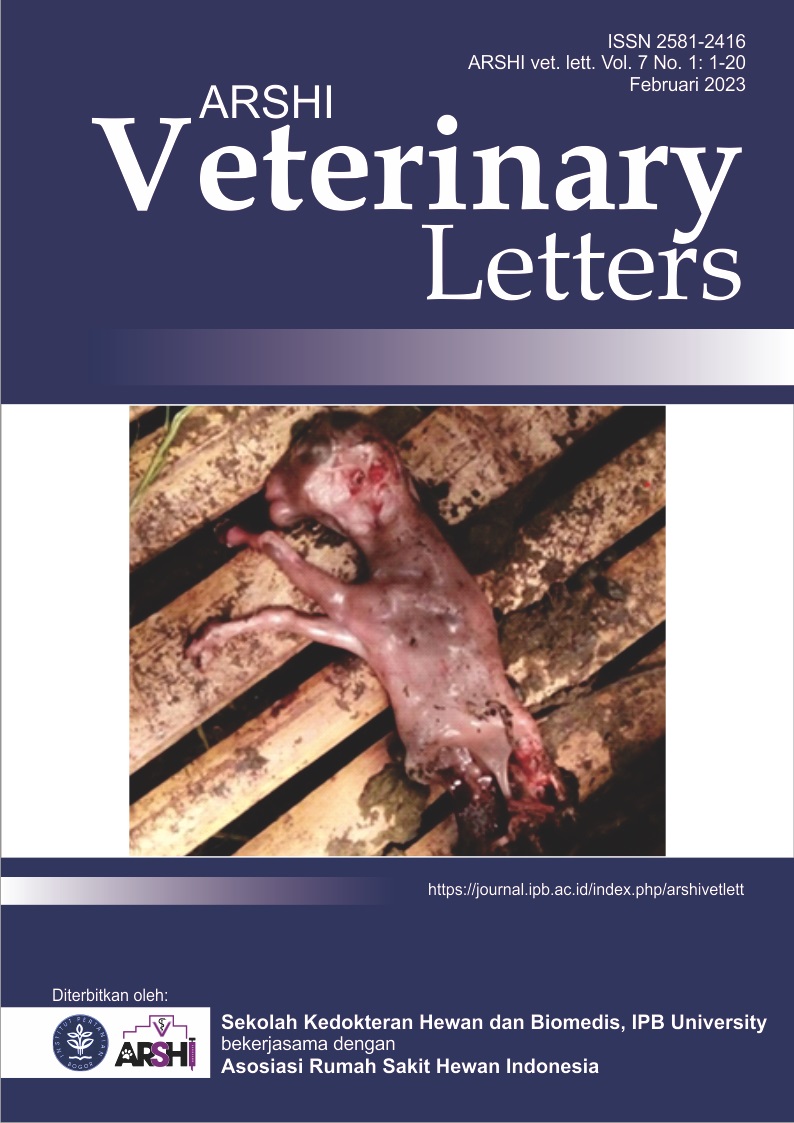Cases of subclinical mastitis in dairy cow at Balai Besar Pembibitan Ternak Unggul dan Hijauan Pakan Ternak Baturraden, Jawa Tengah, Indonesia
Abstract
Subclinical mastitis is a disease that often occurs in lactating dairy cows and has the potential to reduce production, causing economic losses for farmers. Common subclinical mastitis is caused by the bacteria Staphylococcus aureus, Streptococcus agalactiae, and Escherichia coli. This paper aims to report clinical signs, methods of diagnosis, and treatment of subclinical mastitis in a dairy cow at the Balai Besar Pembibitan Ternak Unggul dan Hijauan Pakan Ternak, Baturraden. Subclinical mastitis in this case was diagnosed by examination using the California Mastitis Test (CMT). On clinical examination, the cow appeared normal without any signs of inflammation in the udder, while based on examination with CMT, the cow was declared positive for subclinical mastitis with CMT +++ (moderate) in the front left udder, and CMT ++ (mild) in the rear left udder. In this case, the cow was treated with the antibiotic Terrexine LC., which contains the active substances in the form of Cefalexin (200 mg) and Kanamycin monosulphate (100,000 I.U), intramamarily, 3 times every 12 hours (post-milking). Teat dipping using 1% Povidone iodine and separating the cage from healthy cows was also carried out to prevent the spread of disease. On the 7th post-treatment day, the CMT score in the cow's udder decreased and was declared as a mild infection.
Downloads
References
Blowey RW, Edmondson P. 2010. Mastitis Control in Dairy Herds. 2nd ed. Cambridge: CAB International.
Cervinkova D, Vlkova H, Borodacova I, Makovcova J, Babak V, Lorencova A, Vrtkova I, Marosevic D, Jaglic Z. 2013. Prevalence of mastitis pathogens in milk from clinically healthy cows. Veterinarni Medicina. 58(11):567-575.
Ganière JP, Denuault L. 2009. Synergistic interactions between cefalexin and kanamycin in Mueller–Hinton broth medium and in milk. Journal of Applied Microbiology. 107(1):117-125.
Khasanah H, Setyawan HB, Yulianto R, Widianingrum DC. 2021. Subclinical mastitis: Prevalence and risk factors in dairy cows in East Java, Indonesia. Veterinary World. 14(8):2102-2108.
Maneke E, Pridmore A, Goby L, Lang I. 2011. Kill rate of mastitis pathogens by a combination of cefalexin and kanamycin. Journal of Applied Microbiology. 110(1): 184-190.
Martí-De OA, Peris C, Molina MP. 2020. Effect of subclinical mastitis on the yield and cheese-making properties of ewe’s milk. Small Ruminant Research. 184:106044.
Silley P, Goby L, Pillar CM. 2012. Susceptibility of coagulase-negative staphylococci to a kanamycin and cefalexin combination. Journal of Dairy Science. 95(6):3448-3453.
Copyright (c) 2023 CC-BY-SA

This work is licensed under a Creative Commons Attribution-ShareAlike 4.0 International License.
Authors who publish with this journal agree to the following terms:
1. Authors retain copyright and grant the journal right of first publication with the work simultaneously licensed under a Creative Commons Attribution License that allows others to share the work with an acknowledgement of the work's authorship and initial publication in this journal.
2. Authors are able to enter into separate, additional contractual arrangements for the non-exclusive distribution of the journal's published version of the work (e.g., post it to an institutional repository or publish it in a book), with an acknowledgement of its initial publication in this journal.
3. Authors are permitted and encouraged to post their work online (e.g., in institutional repositories or on their website) prior to and during the submission process, as it can lead to productive exchanges, as well as earlier and greater citation of published work (See The Effect of Open Access).


.jpg)














